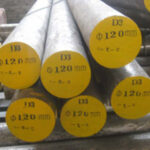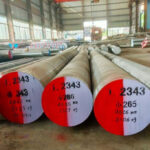Hot work tool steel alloys are the unsung heroes of many manufacturing industries. These specialized materials are engineered to withstand extreme temperatures and mechanical stress, making them indispensable in processes such as forging, die casting, and extrusion. But their significance goes beyond mere durability. Hot work tool steel alloys have a profound impact on tooling efficiency, influencing factors like tool life, machining speed, and the quality of the finished products. In this comprehensive article, we will delve into the world of hot work tool steel alloys and how they play a pivotal role in enhancing tooling efficiency.
1. Introduction to Hot Work Tool Steel Alloys
1.1 What are Hot Work Tool Steel Alloys?
Hot work tool steel alloys are a specialized class of materials designed to excel in high-temperature and high-stress applications. These alloys are engineered to maintain their mechanical properties and structural integrity even when subjected to extreme temperatures during manufacturing processes.
1.2 Importance of Hot Work Tool Steel Alloys
Hot work tool steel alloys are indispensable in industries such as aerospace, automotive, and die casting. Their ability to withstand high temperatures, resist wear, and maintain precision in tooling makes them critical for achieving efficient and high-quality production.
1.3 Role in Various Industries
Hot work tool steel alloys find applications in a wide range of industries, including:
- Die Casting: Where they are used for die casting dies, ensuring the production of intricate and precise components.
- Forging: In the manufacture of forged components, where extreme heat and pressure require durable tooling.
- Extrusion: For creating products like pipes, rods, and profiles with consistent dimensions and surface finish.
- Aerospace: Where precision and reliability are essential for critical components like aircraft engine parts.
2. Key Properties of Hot Work Tool Steel Alloys
2.1 Heat Resistance
One of the primary characteristics of hot work tool steel alloys is their exceptional heat resistance. These alloys can withstand temperatures ranging from 600°C (1,112°F) to 1200°C (2,192°F) without losing their mechanical properties, making them ideal for high-temperature applications.
2.2 Toughness
Hot work tool steel alloys exhibit exceptional toughness, preventing fractures and chipping even under rapid temperature fluctuations and mechanical stress. This toughness contributes to tool longevity and reliability.
2.3 Wear Resistance
Wear resistance is a critical property in tooling materials, and hot work tool steel alloys excel in this regard. They resist wear and abrasion during machining processes, ensuring extended tool life and consistent performance.
2.4 Dimensional Stability
Dimensional stability is crucial for achieving precision in manufacturing. Hot work tool steel alloys maintain their shape and dimensions, even when exposed to extreme temperatures and mechanical forces, leading to consistent and accurate parts production.
2.5 Thermal Conductivity
Efficient thermal conductivity in hot work tool steel alloys helps dissipate heat during machining, preventing localized overheating and ensuring consistent tool performance. This property is vital for maintaining tooling efficiency.
3. Tooling Efficiency: How Hot Work Tool Steel Alloys Make a Difference
3.1 Extended Tool Life
One of the most significant ways hot work tool steel alloys impact tooling efficiency is by extending tool life. Their exceptional toughness and wear resistance minimize tool wear and the need for frequent replacements, reducing downtime and increasing overall efficiency.
3.2 Enhanced Machining Speed
Hot work tool steel alloys allow for enhanced machining speeds due to their ability to withstand high temperatures. This results in quicker production cycles and increased throughput, positively affecting tooling efficiency.
3.3 Improved Surface Finish
Achieving the desired surface finish is crucial in many industries, such as aerospace and automotive. Hot work tool steel alloys contribute to improved surface finish by resisting wear and maintaining tool sharpness throughout the machining process.
3.4 Precision and Consistency
Hot work tool steel alloys play a significant role in achieving precision and consistency in manufacturing processes. Their dimensional stability and thermal conductivity ensure that parts are produced with tight tolerances and minimal variations, leading to efficient and high-quality production.
4. Customizing Hot Work Tool Steel Alloys for Specific Applications
4.1 Tailoring Alloys for Industry Needs
Manufacturers and engineers can customize hot work tool steel alloys to meet specific industry requirements. By selecting the right alloy composition and heat treatment, they can optimize tooling efficiency for particular applications.
4.2 Specialized Alloys for Extreme Conditions
Some industries operate in exceptionally harsh conditions, such as the aerospace and energy sectors. Hot work tool steel alloys can be tailored to withstand these extreme environments, ensuring tooling efficiency and durability.
4.3 Achieving Optimal Tooling Efficiency
Achieving optimal tooling efficiency with hot work tool steel alloys involves a combination of material selection, heat treatment techniques, cutting tool technology, and machining practices. Manufacturers must consider these factors to maximize efficiency and quality in production.
5. Advancements in Hot Work Tool Steel Alloys
5.1 Advanced Alloys for Modern Challenges
Ongoing research and development efforts result in advanced hot work tool steel alloys designed to meet the evolving demands of modern manufacturing. These alloys offer improved performance, efficiency, and sustainability.
5.2 Coatings and Surface Treatments
Coatings and surface treatments can further enhance the properties of hot work tool steel alloys. These treatments provide additional wear resistance, reduce friction, and improve the performance of tooling materials.
5.3 Innovations in Heat Treatment Techniques
Heat treatment techniques continue to evolve, allowing for precise control over the properties of hot work tool steel alloys. These innovations enable manufacturers to optimize tooling efficiency by tailoring the material’s characteristics to specific applications.
6. FAQ: Addressing Common Questions
6.1 What industries benefit the most from hot work tool steel alloys?
Hot work tool steel alloys find extensive use in industries such as aerospace, automotive, die casting, and forging, where high-temperature resistance, toughness, and wear resistance are crucial for efficient and high-quality production.
6.2 Can hot work tool steel alloys be recycled or reprocessed?
Yes, hot work tool steel alloys can be recycled and reprocessed, contributing to sustainable manufacturing practices. Recycling reduces waste and conserves resources while maintaining the material’s performance properties.
6.3 How do hot work tool steel alloys compare to other tooling materials in terms of efficiency?
Hot work tool steel alloys offer unique advantages in terms of high-temperature resistance, toughness, and wear resistance, making them highly efficient in specific applications. However, the choice of tooling material depends on the specific requirements of each application.
6.4 Are there any limitations to using hot work tool steel alloys in tooling applications?
While hot work tool steel alloys offer numerous benefits, they may not be suitable for applications that require extreme hardness or corrosion resistance. In such cases, other materials like cold work tool steel or carbide may be more appropriate.
6.5 What role do hot work tool steel alloys play in sustainable manufacturing?
Hot work tool steel alloys contribute to sustainable manufacturing by extending tool life, reducing the need for frequent replacements, and facilitating recycling practices. Their durability and efficiency help minimize waste and resource consumption in the production process.

